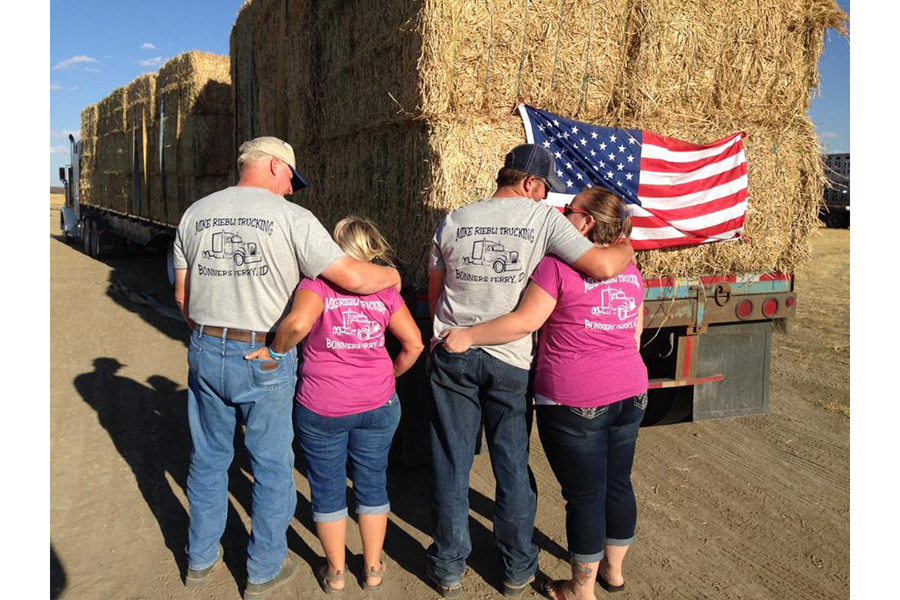Two local women, Shawn Watt of Kalispell and Deena Shotzberger of Libby, are spearheading an ongoing relief effort for farmers and ranchers in eastern Montana’s Garfield County, where the Lodgepole Complex Fire destroyed vast swathes of pastureland.
The fire began on July 19 at 3:17 p.m. near the Charles M. Russell Wildlife Refuge, and 30 mph winds spread the flames for miles along Highway 200, which connects eastern and western Montana. By July 31, 93 percent of the fire had been contained, but the damage had already been done: 270,723 acres of land had been laid utterly bare, according to NorthernAg.net. In addition, 16 homes, 16 structures and numerous miles of fencing had burned down.
Drought exacerbated the problems in Jordan, which is experiencing its driest year in 111 years and has received less than an inch of precipitation in 2017 thus far. Many ranchers’ entire source of livelihood was destroyed in minutes.
When Watt and her husband heard about the fire, their first instinct was to jump into action.
“We thought, ‘This is our chance to pay it forward,’” Watt says.
Ten years ago, Watt’s barn in Bonners Ferry, Idaho burned down in a local fire. She remembers, her voice cracking with emotion, how her neighbors immediately brought over all the hay they could spare so that her cattle wouldn’t starve.
“I’ll never forget that feeling of seeing the hay rolling into the yard,” she says.
Watt connected with Shotzberger on social media after seeing her Facebook post about organizing hay donations from Northwest Montana.
The women created a spreadsheet and started reaching out to people across the valley, asking them if they could donate weed-free hay, trucks or trailers, semis to haul large hay squares or rounds, funds to cover fuel costs, fencing supplies, and/or labor to pick up and load the hay.
The Kalispell chapter of the FFA donated 10 tons of hay.
“We were just a small part of the effort, but it was so inspirational to see how the community responded,” says Justin Heupel, an agricultural education instructor and FFA advisor.
In less than two weeks, the women had amassed 135 tons of donated hay, four semis and three pickups with trailers to make the 460-mile trip to Jordan from Columbia Falls on the weekend of Aug. 12. There was also a contingent of volunteers who made the 613-mile trip from Bonners Ferry.
On her Facebook page, Watt posted periodic videos of the caravan driving to Jordan, American flags draped across the hay bales, with the hashtags #MontanaStrong, #TimberCountyHay, and #AmericaStrong in her captions.
When they arrived at Dutton Ranch in Sand Springs, just outside of Jordan, it was “an ominous sight,” Watt says. “The only thing that wasn’t black was a 200-yard area around the house.”
“The rancher we gave the hay to was 81 years old,” she continues. “He could barely talk for two hours because of the emotions he was going through, but neither could I.”
Watt says the trip made her aware of the extreme magnitude of the fire’s destruction, adding that their hay contribution essentially amounted to “a giant alfalfa hug.”
“It is literally one drop in a five-pound bucket,” she says. “The hay that we brought will only last one farmer for eight days.”
Garfield County will need an estimated 34,000 tons of hay to feed 7,700 head of cattle through June 1, 2018, when the pastureland is predicted to start growing again.
“What we need to do now is find a sustainable source for the hay from an area closer to Jordan,” Watt says. “Flathead Valley prices are too expensive. It’s simply not affordable to pay $150 per ton of hay and then $35 per ton to haul it.”
She adds that one of the truckers who volunteered to drive to Jordan on Aug. 12, Jonathan Allen, managed to broker a deal with a rancher in Minnesota for hay at $37 per ton.
“He went ahead and bought it all out of his own pocket,” Watt says. “We’re collecting donations now to pay him back.”
Watt is currently focused on establishing a more sustainable hay transportation system, in which truckers hauling hay to eastern Montana could link up with a dispatcher there who would provide them with freight to haul back, thus mitigating their travel costs.
“Sometimes my husband jokes, ‘I just wanted to run a load of hay over to Jordan, and now it’s our whole life!’” Watt says, laughing. “But, in reality, nothing has ingrained us more in the community than this.”
“I’ve seen so much good in doing this,” she adds. “There are people who care enough to impart their own knowledge and expertise for no other reason than to help. And in today’s world, I needed to know that there are more good people than bad, more generous people than scrooges, and more loving people than not.”
For more information and to donate supplies, reach out to area coordinators listed here: www.northernag.net/AGNews/AgNewsStories/TabId/657/ArtMID/2927/ArticleID/8283/Montana-Wildfire-Relief-Heres-How-you-Can-Help.aspx. To participate in an online auction raising money for Garfield County, visit www.facebook.com/groups/458421027890168. To help pay back Allen’s hay costs, visit www.paypal.me/2017Hayrelief. Reach Shawn Watt at [email protected] and Deena Shotzberger at [email protected] with subject line “HAY.”
